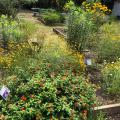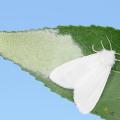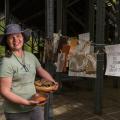Bark Beetles in Urban Pines
Blake Layton, Ph.D., and John Riggins Ph.D.
Mississippi State University
Last year many homeowners in drought-affected areas of the state lost mature pines due to the combination of drought and subsequent attack by bark beetles. It was a bad year for pines and a good year for bark beetles! Homeowners who lost trees, or see dead trees in their neighborhood, are understandably concerned about what might happen this year. “Will pine trees continue to die, and what can we do to protect them?”
First, we must recognize that drought, not bark beetles, was the main cause of last year’s problems, and many trees likely died due to drought alone. But drought-stressed trees are more susceptible to bark beetles, and bark beetles also kill trees. For most people, it is difficult to know whether a dead pine tree was killed by drought, bark beetles, or some other cause.
Trees that were attacked by bark beetles will initially have chewing gum-sized balls of pitch on the bark at points where beetles bored in. When the next generation beetles bore out they leave small, clean birdshot-sized holes in the bark. If southern pine beetles are the culprits, cutting away a section of bark will reveal characteristic winding, S-shaped galleries through the inner bark. Ips beetle galleries have a different shape.
Fine white saw dust around the base of a dead pine is not from bark beetles and does not necessarily indicate the tree was killed by bark beetles. This white sawdust is produced by ambrosia beetles, which are secondary invaders that readily bore into dead pines, regardless of why they died. Within the first few weeks after death, trees killed by drought, lightning, or other causes may also have this ring of white sawdust at their base.
Bark Beetles:
Pines are attacked by a complex of bark beetles: black turpentine beetles, southern pine beetles (SPB) and Ips beetles (several species). In general, black turpentine beetles attack the lower six to eight feet of the trunk; SPB, attacks the main trunk, up to the lower limbs in the crown; and Ips beetles focus on limbs and stems in the crown area. But 6-spined Ips will also attack the main trunk. Both SPB and Ips infect trees with blue stain fungi, which infects the sapwood, interferes with water translocation, and can ultimately kill trees, even without further help from the beetles. SPB is the most important bark beetle, but Ips beetles also kill pine trees.
Healthy pines defend themselves from bark beetle attacks by attempting to “pitch them out” by producing large amounts of sap/resin as the beetles are boring in. Healthy trees with adequate soil moisture are better able to defend themselves than are injured or drought stressed trees. The general sequence of drought stress, beetle attack, and tree death is as follows.
First the drought weakens the trees, so they are less able to defend themselves. Then the beetles attack, either southern pine beetles or Ips beetles. As they begin to bore into the tree, the beetles release pheromones which attract other beetles, greatly increasing the number of attack holes and overwhelming the tree’s ability to produce enough sap to defend itself. Once the beetles reach the inner bark, they create winding galleries and egg niches, which they inoculate with a special fungus that will grow and provide food for the larvae (this is not blue stain). During this time, trees are also infected with blue stain fungi which invades the sapwood and further weakens the tree. Blue stain alone can cause tree death, but the beetles also kill trees as they tunnel through the phloem layer (inner bark), quickly girdling the tree.
Mature larvae pupate in their galleries beneath the bark and then emerge as adults, leaving small birdshot-sized holes, with no surrounding pitch, in the exterior bark. Then secondary beetles, first ambrosia beetles, then pine sawyers and others come in to feed on the dead or dying trees. Then termites show up. There is research to show termites especially like wood with blue stain fungi, but they like dead pines without it too.
SPB populations are cyclic in nature. Heavy outbreaks result in increases in predatory insects and diseases that attack the pine beetles, ultimately suppressing them to below problem levels. On average, SPB outbreaks last one to three years. This makes occurrence and duration of outbreaks difficult to predict. Even if dry conditions do not return this summer, the SPB problem could continue, and many homeowners, especially those who learned how costly it can be to have dead trees removed, are interested in what they can do to help protect high value trees.
Control Options:
Protecting pines from beetle attack must be done preventively. Once a tree is under attack, as evidenced by significant numbers of pitch tubes or attack holes (drought-stricken trees do not always produce pitch tubes) on the trunk, and beetles have bored into the inner bark, it is too late to save that tree. But there are things homeowners can do to reduce the risk of beetle attack.
Timely Irrigation: One of the most important things homeowners can do to protect pines in landscapes is to keep them well-watered during times of drought (approximately 1 inch of water a week during droughts). This keeps trees healthy and well hydrated, making them less attractive to beetles in the first place and allows them to produce more resin to pitch out attacking beetles. Unfortunately, supplemental watering is often not possible or practical.
Insecticide/Fungicide Trunk Injection: Emamectin benzoate (TreeAge, Tree Mec, Boxer, and others) is an insecticide that can injected into the trunk to provide up to two years of protection from SPB and Ips attack. This is costly, up to a few hundred dollars a tree for large trees, but it is the best preventive treatment available, with a single treatment providing two years of protection. Because beetles can inoculate trees with blue stain fungi before they are killed by this treatment, it is best to include an approved systemic fungicide, such as propiconazole (Propizol, etc.) along with the insecticide.
Trunk injection is a specialized treatment requiring specialize equipment, and relatively few companies provide this service. Consequently, it can be difficult to find and schedule someone to perform trunk injections, but it may be worthwhile on high value trees.
When to apply: Because of the long residual control, timing is relatively flexible, but treatments applied during the late winter months, January-early March, will protect against first generation overwintered beetles and remain active throughout the year. However, preventive treatments can also be applied anytime during the growing season, provided trees are not already infested or under attack, or so drought-stressed they are unable to absorb the products.
Preventive Bark Sprays: Bark beetle attacks can also be prevented by spraying tree trunks with an effective pyrethroid insecticide, such as bifenthrin (OnyxPro is an example) or permethrin (Perm-up is one example). These work preventively, by killing beetles as they crawl over the bark and begin their attack. However, such sprays are often not safe or feasible to apply in urban settings due to concerns about off-target drift and because of the difficulty of getting adequate spray coverage on taller trees.
When to apply: Bark spray treatments are best applied in early spring, just before beetles begin to emerge. However, this is difficult to predict. First bloom of redbuds is sometimes used as an indicator for spring bark beetle emergence, but peak spring emergence of SPB can occur as early as February or as late as April. Preventive bark sprays can also be applied throughout the growing season as long as trees are not already infested.
What About Cutting Trees: Proactively removing trees, either pines or other unwanted trees, to eliminate or reduce overcrowding and/or to remove weak or damaged trees will help reduce potential for bark beetle injury to remaining pines. When cutting and removing trees from landscapes, it is important to avoid injury, including soil compaction and rutting over remaining tree roots, as this makes trees more susceptible to future attacks.
Removing dead pine trees—trees that already have red tops and loose bark--from a landscape will not help control SPB because the beetles will have already left those trees. However, because pines deteriorate relatively quickly, it is still important to remove such hazard trees promptly. Cutting dying or recently dead trees that are still actively infested can help reduce future spread—by causing developing larvae and pupae to die before they can complete their life cycle. Having such trees immediately burned or otherwise removed from the landscape can further reduce potential for reinfestation. But the time window for this action is narrow as bark beetles complete a generation in about four weeks during warm months.
Bark Beetle Notes
Biology notes:
- Three groups of bark beetles attack Southern pines: southern pine beetle (SPB), Ips, and black turpentine beetle (BTB).
- Southern pine beetle is the most important. SPB attacks the main trunk, up to the lower crown area.
- Ips beetles also kill pines. There are three species of Ips.
- Most Ips attacks are focused on limbs and the main stem in the crown, but 6-spined Ips will also attack the main trunk and may occur in combination with SPB.
- Ips also breed in fresh slash from downed trees.
- Black turpentine beetle (BTB) attacks the lower 6 to 8 feet of the trunk, including the root flare.
- Healthy trees defend themselves from bark beetles by “pitching them out”-- producing excessive resin at the attack site to push out and/or entomb beetles before they bore in.
- Trees that are drought stressed, injured, or weakened by other factors are less able to produce pitch and defend themselves. Severely drought-stricken trees may be unable to produce pitch tubes.
- SPBs can also attack healthy trees, especially during outbreaks, but much prefer stressed or injured trees.
- In commercial timber, excess stand density is a key predisposing factor for SPB attack.
- Trees that are overcrowded in landscapes are also more susceptible.
- When attacking a tree, beetles emit pheromones to attract other beetles. This results in more bore holes, overwhelming the tree’s ability to produce enough resin to defend itself.
- “Pitch tubes” or masses of resin on tree bark are a sign of initial beetle attack.
- But trees that are severely drought stressed may not be able to produce pitch tubes.
- SPB and Ips also produce fine reddish-brown sawdust in bark crevices as they bore into and through tree bark.
- Both SPB and Ips inoculate trees with blue stain fungi, which further weakens the tree by blocking water transport and makes trees even more susceptible to beetle attacks.
- Blue stain fungi alone will kill trees, but it is usually accompanied by beetles.
- Black turpentine beetle is much less likely to transmit blue stain fungus.
- SPB lay eggs in winding galleries they create in the inner bark, inoculating them with a special fungus (not blue stain) which grows and provides food for the resulting larvae.
- These galleries girdle the phloem layer and kill the tree.
- SPB can complete a generation in a month or less during warm weather but may take several months during winter.
- SPB produces several generations per year, but usually only one generation per tree, because trees are usually killed by a single generation of beetles/blue stain and SPB does not attack dead trees.
- Young adult beetles leave birdshot-sized holes in tree bark when they emerge. These holes are not surrounded by, or plugged with, resin.
- After trees are attacked and killed by bark beetles, they are colonized by many other wood-boring beetles. Most are not pests that kill trees; they only use dead/dying trees.
- Large amounts of white sawdust around the base of a dead or dying pine is not from SPB. This usually from ambrosia beetles, which are one of the first secondary borers to arrive.
- Bark beetles only tunnel through inner bark. They do not bore deep into sapwood.
- Ambrosia beetles do bore into sapwood.This is why they produce fine white sawdust.
- Pitch tubes on trunks are made by SPB going in. Clean birdshot holes in bark are made by SPB coming out. White sawdust around base of trees is from ambrosia beetles.
- Although adult SPB can fly as far as one or two miles, attacks by the next generation are usually focused on nearby trees.
- SPB produces several generations per year. During outbreak years infestations gradually expand during the growing season as beetles leave old trees and attack new trees.
- SPB populations are cyclic, and heavy outbreaks eventually subside, with periods of heavy populations usually being followed by several years of low populations.
- Outbreaks eventually collapse due to natural biological control—increased numbers of predatory and parasitic insects and diseases that attack SPB and reduce their numbers.
Control Notes:
- Treatments for SPB must be applied preventively—before beetle attacks begin.
- When possible, keeping trees adequately watered during periods of drought is one the best things homeowners can do to help protect pines from bark beetles—and drought.
- Trunk injection with emamectin benzoate is the most effective preventive treatment for SPB. Such treatments are pricy and must be applied by a commercial applicator.
- Trunk injections of emamectin benzoate will kill beetles as they are boring in, and will kill any hatching larvae, but they will not prevent blue stain fungi.
- Once beetles have bored into the tree, they will inoculate it with blue stain fungus, and the blue stain fungus can still kill trees, even if the beetles are controlled.
- When using trunk injection, trees should also be injected with an appropriate fungicide (propiconazole), at the same time as the insecticide injection, to control blue stain fungi.
- Preventive trunk sprays with bifenthrin or permethrin can help prevent bark beetles, but such sprays often are not safe or feasible in urban settings.
- Bark sprays will not control beetles that have already bored into the tree.
Final Notes:
- It is difficult to know whether treating landscape pines preventively for bark beetles will be justified. Populations and outbreaks are cyclic and difficult to predict.
- Most preventive bark beetle treatments are probably unnecessary because the beetles probably will not attack the tree anyway.
- Drought, and other stresses, such as over-crowding, trunk injury, soil compaction, or disease issues, make trees more susceptible to bark beetles.
- It is difficult to predict when periods of prolonged drought will occur and to then apply preventive bark beetle treatments in a timely manner.
- Homeowners and landscape managers with high value pines, trees that are critical to the landscape or prohibitively expensive to remove, may consider preventive beetle treatments to be worthwhile.
Publications
News
A grant from Coast Electric will allow for a renovation of the Mississippi State University Crosby Arboretum’s pollinator garden. Pat Drackett, director of the arboretum, said the pollinator garden was established in 2001 as the Explorers’ Garden. It is a 3,000-square-foot space with a variety of native and other plants that helps teach visitors how to create havens for pollinators.
The 2020 Fall Flower & Garden Fest will be a virtual, educational event this year.
A tent for camping in the woods can be a good thing, but a tent filled with caterpillars in a pecan tree can be bad news for homeowners.
Success Stories
Robin Whitfield, who gave the child the paper, stands awestruck, watching her friend’s daughter use the flower to draw and color on the page.




